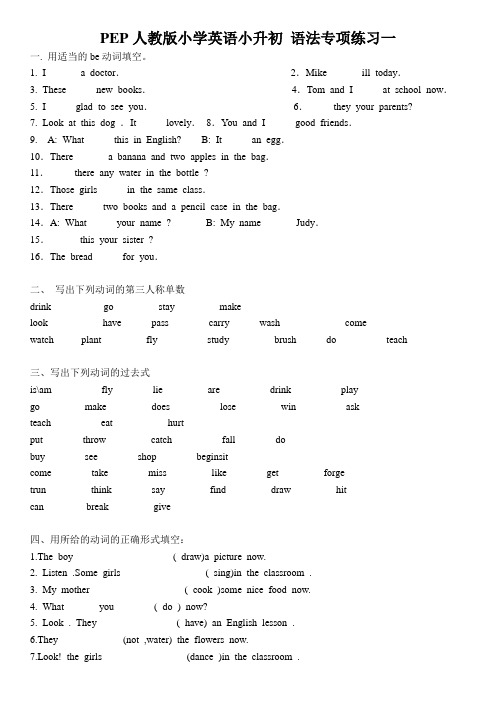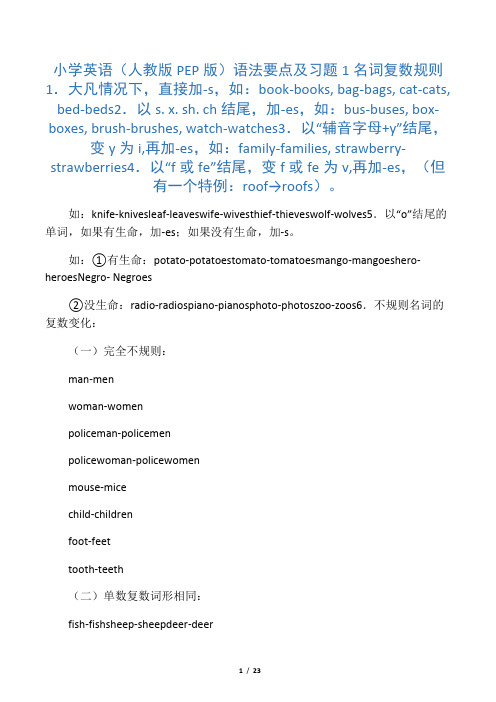【最新】人教PEP版小升初英语语法习题汇总
小学英语(人教版PEP版)语法要点详解及练习题-六年级-小升初必备大全

名词复数规则1.一般情况下,直接加-s,如:book-books, bag-bags, cat-cats, bed-beds2.以s. x. sh. ch结尾,加-es,如:bus-buses, box-boxes, brush-brushes, watch-watches 3.以“辅音字母+y”结尾,变y为i, 再加-es,如:family-families, strawberry-strawberries 4.以“f或fe”结尾,变f或fe为v, 再加-es,(但有一个特例:roof→roofs)。
如:knife-knives leaf-leaves wife-wives thief-thieves wolf-wolves5.以“o”结尾的单词,如果有生命,加-es;如果没有生命,加-s。
如:①有生命:potato-potatoes tomato-tomatoes mango-mangoeshero-heroes Negro- Negroes②没生命:radio-radios piano-pianos photo-photos zoo-zoos6.不规则名词的复数变化:(一)完全不规则:man-menwoman-womenpoliceman-policemenpolicewoman-policewomenmouse-micechild-childrenfoot-feettooth-teeth(二)单数复数词形相同:fish-fish sheep-sheep deer-deerpeople-peopleChinese-ChineseJapanese-Japanese小练习:写出下列各词的复数I _________him _________this ___________her ______watch _______child _______photo ________diary ______day________ foot________ book_______ dress ________tooth_______ sheep ______box_______ strawberry _____thief _______yo-yo ______ peach______ sandwich ______man______ woman_______ paper_______ juice___________ water________ milk________ rice__________ tea__________2 一般现在时一般现在时基本用法介绍【No. 1】一般现在时的功能1.表示事物或人物的特征、状态。
小学英语(人教版pep版)语法要点详解及练习题-六年级-小升初必备大全[1]
![小学英语(人教版pep版)语法要点详解及练习题-六年级-小升初必备大全[1]](https://img.taocdn.com/s3/m/55c7928b9b6648d7c0c74602.png)
小学英语〔人教版PEP版〕语法要点及习题1名词复数规那么1.一般情况下,直接加-s,如:book-books, bag-bags, cat-cats, bed-beds2.以s. x. sh. ch结尾,加-es,如:bus-buses, box-boxes, brush-brushes, watch-watches 3.以“辅音字母+y〞结尾,变y为i, 再加-es,如:family-families, strawberry-strawberries 以“f或fe〞结尾,变f或fe为v, 再加-es,〔但有一个特例:roof→roofs〕。
如:knife-knives leaf-leaves wife-wives thief-thieves wolf-wolves5.以“o〞结尾的单词,假如有生命,加-es;假如没有生命,加-s。
如:①有生命:potato-potatoes tomato-tomatoes mango-mangoeshero-heroes Negro- Negroes②没生命:radio-radios piano-pianos photo-photos zoo-zoos6.不规那么名词的复数变化:〔一〕完全不规那么:man-menwoman-womenpoliceman-policemenpolicewoman-policewomenmouse-micechild-childrenfoot-feettooth-teeth〔二〕单数复数词形一样:fish-fish sheep-sheep deer-deerpeople-peopleChinese-ChineseJapanese-Japanese小学英语〔PEP版〕语法总结及习题2一般如今时一般如今时根本用法介绍【No. 1】一般如今时的功能1.表示事物或人物的特征、状态。
如:The sky is blue.天空是蓝色的。
2.表示经常性或习惯性的动作。
(最新)人教pep版小升初英语语法专项训练

专项训练---动词Be 一.用be动词适当的词填空。
1. I ________ from Australia.2. She _______ a student.3.Jane and Tom _________ my friends.4. My parents _______ very busy every day.5. I ______ an English teacher now.6. Where _________ you from?7. The light _________ green.8. My name _________ Li Dong.9. I _________ twelve.10._________ they your new friends?11. I ______ a boy.12. ______ you a boy? No, I _____ not.13. The girl______ Jack's sister.14. The dog _______ tall and fat.15. ______ your brother in the classroom?16. Where _____ your mother? She ______ at home.17. Whose dress ______ this?18. That ______ my red skirt.19. The books_______under the table.20. Who ______ I?21. Some tea ______ in the glass.22. Gao shan's shirt _______ over there.23. My sister's name ______Nancy.24. This ______ not Wang Fang's pencil.25. ______ David and Helen from England?26. We ____ friends.27. She ___ a teacher.28. I ___ a girl.29. Many ants ____ in my house.30. His mother ____ fat.31. He _____ in Class 4, Grade 1.32. What _____ your name?33. These _____ buses.34. What class _____ you in?35. It_____ a car.36. Helen____ a student37. This _____my book.38. My father______a cook.39. Jack’s friend____in Class One.40. You ____ a doctor.二.选择1.She ______ Miss Hen. A.be B.am C.is2.I ______ sorry. A./ B.am C.are3.Here ______ my ball. A.is B.are C.am4.You ______ number eight. A.are B.is C.am5.What_______this. A.is B.are C.be6.Helen____ a student. A.be B.am C.is7.Those _____oranges. A.is B.are C.am8. How old_____your teacher? A.be B.am C.is9. Where __ ___ her mother? A.are B.is C.am10.The two cups of milk _____ for me. A.is B.are C.be三. 将下列句子变成否定句和一般疑问句1.His brother is a teacher. 否定句:一般疑问句:2.Those are his parents.否定句:一般疑问句:3.I’m 14 years old.否定句:一般疑问句:4.The ruler is on the table. 否定句:一般疑问句:5.Tom is my teacher .否定句:一般疑问句:6.My shoes are 20 yuan .否定句:一般疑问句:7.This is a pen .否定句:一般疑问句:8.My name is Andy.否定句:一般疑问句:9.We are twins.否定句:一般疑问句:10.He is my brother.否定句:一般疑问句:专项训练---There be 句型一.根据所给汉语完成句子。
(完整版)小学英语(人教版PEP版)语法要点详解及练习题-六年级-小升初必备大全(17页)

小学英语(人教版PEP版)语法要点及习题1名词复数规则1.一般情况下,直接加-s,如:book-books, bag-bags, cat-cats, bed-beds2.以s. x. sh. ch结尾,加-es,如:bus-buses, box-boxes, brush-brushes, watch-watches 3.以“辅音字母+y”结尾,变y为i, 再加-es,如:family-families, strawberry-strawberries 以“f或fe”结尾,变f或fe为v, 再加-es,(但有一个特例:roof→roofs)。
如:knife-knives leaf-leaves wife-wives thief-thieves wolf-wolves5.以“o”结尾的单词,如果有生命,加-es;如果没有生命,加-s。
如:①有生命:potato-potatoes tomato-tomatoes mango-mangoeshero-heroes Negro- Negroes②没生命:radio-radios piano-pianos photo-photos zoo-zoos6.不规则名词的复数变化:(一)完全不规则:man-menwoman-womenpoliceman-policemenpolicewoman-policewomenmouse-micechild-childrenfoot-feettooth-teeth(二)单数复数词形相同:fish-fish sheep-sheep deer-deerpeople-peopleChinese-ChineseJapanese-Japanese小练习:写出下列各词的复数I _________him _________this ___________her ______watch _______child _______photo ________diary ______day________ foot________ book_______ dress ________tooth_______ sheep ______box_______ strawberry _____thief _______yo-yo ______ peach______ sandwich ______man______ woman_______ paper_______ juice___________water________ milk________ rice__________ tea__________小学英语(PEP版)语法总结及习题2一般现在时一般现在时基本用法介绍【No. 1】一般现在时的功能1.表示事物或人物的特征、状态。
PEP人教版小学英语 小升初 语法专项练习

PEP人教版小学英语小升初语法专项练习一一. 用适当的be动词填空。
1. I _____ a doctor.2.Mike _____ ill today.3. These_____ new books.4.Tom and I_____ at school now.5. I _____glad to see you.6._____they your parents?7. Look at this dog .It_____ lovely.8.You and I _____good friends.9. A: What_____ this in English? B: It _____an egg.10.There _____ a banana and two apples in the bag.11._____there any water in the bottle ?12.Those girls _____in the same class.13.There _____two books and a pencil case in the bag.14.A: What_____ your name ? B: My name _____ Judy.15._____this your sister ?16.The bread _____for you.二、写出下列动词的第三人称单数drink ________ go _______ stay ________make ________look _________ have______pass_______ carry ____ wash___________ come________watch_____ plant_______ fly ________ study_______ brush______do_________ teach______三、写出下列动词的过去式is\am_________ fly_______ lie________ are ________ drink_________ play_______go________ make ________does_________ lose________ win________ ask _____teach_________ eat__________ hurt________put ______ throw________ catch_________ fall_______ do ________buy________see________shop________beginsit________come________take________miss ________like________get________ forge________trun ________think________say ________find________ draw ________hit________can________ break ________give ________四、用所给的动词的正确形式填空:1.The boy __________________ ( draw)a picture now.2. Listen .Some girls _______________ ( sing)in the classroom .3. My mother _________________ ( cook )some nice food now.4. What _____ you ______ ( do ) now?5. Look . They _______________( have) an English lesson .6.They ____________(not ,water) the flowers now.7.Look! the girls ________________(dance )in the classroom .8.What is our granddaughter doing? She _________(listen ) to music.9. It’s5 o’clock now. We _____________(have)supper now10.______Helen____________(wash )clothes? Yes ,she is .11. Mike _________ (do) his homework every day.12. There __________(be) some water in the glass.13. We like ________ (play) basketball after class.14. I like singing. I often _________(listen) to the music in the evening.15. My grandma_________(watch) TV every day.16. There ________(are) five books on the desk a moment ago.17. They ________(sweep) the floor just now.18. I _______(is) ten years old last year. On that day, I _______(blow) the candles out.19. I _________ (meet) Miss White the day before yesterday.20. I _______ (wash) clothes last weekend.五、选择最佳的答案:1. _________Alice often play the piano. No, she __________.A. Do; doB. Does; doesC. Does; doesn’t2. ________ your pen friend _______ in Beijing?A. Do; liveB. Do; livesC. Does; live3. Tom and Mike _______ very excited, they will take a trip.A. isB. areC. am4. I like ________ very much. What about you?A. danceB. dancedC. dancing5. I can’t find my pen. Let me _______.A. go and ask herB. go and ask hersC. go and ask she6. Fangfang is a good student. She _______maths.A. does good atB. well do itC. is good at7. The kite _______ a bird.A. look likeB. is lookingC. looks like8. Bill and I _______ good friends.A. isB. areC. am9. Sandy often ________ his homework on Sundays .A. doB. doesC. did10. What do you usually do on the weekend? I __________.A. went swimmingB. go swimmingC. visited grandparents。
小学英语(人教版PEP版)语法要点详解及练习题-六年级-小升初必备大全

小学英语(人教版PEP版)语法要点及习题1名词复数规则1.大凡情况下,直接加-s,如:book-books, bag-bags, cat-cats, bed-beds2.以s. x. sh. ch结尾,加-es,如:bus-buses, box-boxes, brush-brushes, watch-watches3.以“辅音字母+y”结尾,变y为i,再加-es,如:family-families, strawberry-strawberries4.以“f或fe”结尾,变f或fe为v,再加-es,(但有一个特例:roof→roofs)。
如:knife-knivesleaf-leaveswife-wivesthief-thieveswolf-wolves5.以“o”结尾的单词,如果有生命,加-es;如果没有生命,加-s。
如:①有生命:potato-potatoestomato-tomatoesmango-mangoeshero-heroesNegro- Negroes②没生命:radio-radiospiano-pianosphoto-photoszoo-zoos6.不规则名词的复数变化:(一)完全不规则:man-menwoman-womenpoliceman-policemenpolicewoman-policewomenmouse-micechild-childrenfoot-feettooth-teeth(二)单数复数词形相同:fish-fishsheep-sheepdeer-deerpeople-peopleChinese-ChineseJapanese-Japanese小练习:写出下列各词的复数I _________him _________this ___________her ______watch _______child _______photo ________diary ______day________ foot________ book_______ dress ________tooth_______ sheep ______box_______ strawberry _____thief _______yo-yo ______ peach______ sandwich ______man______ woman_______ paper_______juice___________water________ milk________ rice__________ tea__________小学英语(PEP版)语法总结及习题2大凡现在时大凡现在时基本用法介绍【No. 1】大凡现在时的功能1.表示事物或人物的特征、状态。
人教版PEP小学英语语法习题集

人教版PEP小学英语语法习题集PEP小学英语语法题一、名词复数写出下列各词的复数:I - we。
him - them。
this - these。
her - them。
watch - watches。
child - children。
photo - photos。
diary - diaries。
day - days。
foot - feet。
book - books。
dress - dresses。
tooth - teeth。
sheep - sheep。
box - boxes。
peach - peaches。
sandwich - sandwiches。
man - men。
woman - women。
paper - papers。
juice - juices。
water - waters。
milk - milks。
rice - rices。
tea - teas.二、一般现在时写出下列动词的第三人称单数:drink - drinks。
go - goes。
stay - stays。
make - makes。
look - looks。
have - has。
pass - passes。
carry - carries。
come - comes。
watch - watches。
plant -plants。
fly - flies。
study - studies。
brush - brushes。
do - does。
teach - teaches.用括号内动词的适当形式填空:1.He often has dinner at home.2.Daniel and Tommy are in Class One.3.We do not watch TV on Monday.4.Nick does not go to the zoo on Sunday.5.Do they like the World Cup?6.What do they often do on Saturdays?7.Do your parents read newspapers every day?8.XXX.9.She and I take a walk XXX.10.There is some water in the bottle.11.XXX XXX cooking.12.They have the same hobby.13.XXX.14.You always do your homework well.15.I am ill。
【推荐】小学英语(人教版PEP版)语法要点详解及练习题-六年级-小升初必备大全[1]
![【推荐】小学英语(人教版PEP版)语法要点详解及练习题-六年级-小升初必备大全[1]](https://img.taocdn.com/s3/m/92883a7376c66137ee0619f2.png)
小学英语(人教版PEP版)语法要点及习题1名词复数规则1.一般情况下,直接加-s,如:book-books, bag-bags, cat-cats, bed-beds2.以s. x. sh. ch结尾,加-es,如:bus-buses, box-boxes, brush-brushes, watch-watches 3.以“辅音字母+y”结尾,变y为i, 再加-es,如:family-families, strawberry-strawberries 4.以“f或fe”结尾,变f或fe为v, 再加-es,(但有一个特例:roof→roofs)。
如:knife-knives leaf-leaves wife-wives thief-thieves wolf-wolves5.以“o”结尾的单词,如果有生命,加-es;如果没有生命,加-s。
如:①有生命:potato-potatoes tomato-tomatoes mango-mangoeshero-heroes Negro- Negroes②没生命:radio-radios piano-pianos photo-photos zoo-zoos6.不规则名词的复数变化:(一)完全不规则:man-menwoman-womenpoliceman-policemenpolicewoman-policewomenmouse-micechild-childrenfoot-feettooth-teeth(二)单数复数词形相同:fish-fish sheep-sheep deer-deerpeople-peopleChinese-ChineseJapanese-Japanese小练习:写出下列各词的复数I _________him _________this ___________her ______watch _______child _______photo ________diary ______day________ foot________ book_______ dress ________tooth_______ sheep ______box_______ strawberry _____thief _______yo-yo ______ peach______ sandwich ______man______ woman_______ paper_______ juice___________water________ milk________ rice__________ tea__________小学英语(PEP版)语法总结及习题2一般现在时一般现在时基本用法介绍【No. 1】一般现在时的功能1.表示事物或人物的特征、状态。
- 1、下载文档前请自行甄别文档内容的完整性,平台不提供额外的编辑、内容补充、找答案等附加服务。
- 2、"仅部分预览"的文档,不可在线预览部分如存在完整性等问题,可反馈申请退款(可完整预览的文档不适用该条件!)。
- 3、如文档侵犯您的权益,请联系客服反馈,我们会尽快为您处理(人工客服工作时间:9:00-18:30)。
小学英语语法练习题名词练习2.写出下列单数名词的复数形式1.orange_____2.box__________3.woman________4.tomato________5.bus_______ 7.b oy________ 8.baby _______ 9.watch_______ 10.photo________ 11.class _______ 12.foot________13.house________14.pen_______ 15.car________ 16.horse________ 17.radio_______ 18.dish________19.child________2.将下列单词的复数形式改成单数形式1.doctors_________2.cities_______3.pianos__________4..ears________5.churches ________6.leaves_________7.teeth________8.zoos____9.brushes________ 10.wives__________11.men _________12.pears _________3.请从括号里选出正确的答案1. Please give me (two /two cups of )coffee.2. There are a lot of (sheep /sheeps ) on the farm.3. I’d like some (bread / breads ) and (potato /potatoes).4. Look! There is a (mouse /mice) in the corner.5. He bought (a piece of /a piece ) paper.6. “Where is (Woman’s / Women’s) Room?” asked Susan.7. (The girl’s/The girls’ )hobby is drawing.8. Aunt Lucy sent (a child’s /a children’s ) book to me.冠词练习1.在空格内填上a或an1._____ear2.______actor3._____hen4.______toy5.____university6.______elepha nt7.______hat8.______umbrella9.______rabbit 10.______idea11.______h our 12_______ honest boy 13.______interesting book14.______easy question15.______orange dress 17_______X-ray machine 18.______ice cream2.选择填空1.Mom tells her little daughter old story every night. A.a B. / C. an D. the2. computer on the table is Susan’s. A. A B. An C. The D. /3.There is map of the world on wall. map is mine.A. a, a, AB. a, the, TheC. the, the, TheD. the, the, A5. Spring comes after winter. A. /, / B.The, / C.The, the D.A, the6.I bought shoes yesterday. shoes are very beautiful.A. a, TheB. a pair of, TheC. the, TheD. a pair, The pair7.He was soldier in the Second World War. A. a B. an C. the D. /8.She can play and .A. the tennis, the guitarB. tennis, guitarC. the tennis, guitarD. tennis, the guitar9.I can see moon and clouds in the sky. A. the,a B. a, a C. the, / D. the, the11. Tian’anmen Square is in Beijing. A. /, / B. A, / C. The, / D. /, the12.—Can you tell me nearest bookshop?—Go straight and turn right at_______third crossing, and you will see it.A. the, aB. the, theC. a, theD. the, /5.根据中文,写出下列固定搭配的英文。
1.拉小提琴______________2.总而言之______________3.看一看________________4.在早上________________5.顺便说一下___________6.在左边________________7.吃晚餐________________ 8.下棋__________________9.在家_______________ 10.开始时_________数词练习1.写出与下列词相应地数序数词或基数词。
1. one2. two3. three4. nine5.twelve 6. twenty7. eighty-eight 8. sixty-two 9. fifty-four 10. four hundred11. sixth 12. thirteenth 13. eleventh 15. ninety-sixth2.选择填空1._______ of the visitors are foreigners. A. Three five B. Three-fifth C. Three-fifths D. third five2. There are _______ people on the square. A. hundreds B. hundred of C. hundreds of D. five hundreds3. The teacher asked us to write a _______composition in one hour.A. three-hundred-wordsB. three hundreds of wordsC. three-hundreds-wordsD. three-hundred-word4. ------What _____is Charlie in?----He is in ________A. row, row FourB. row, Row FourC. rows, four rowD. rows, rows Four5. ------How much is five ______six? ---Eleven. A. plus B. minus C. times D. divided代词练习1.根据括号中的要求给出下列代词的适当形式。
1.it_______(形容词性物主代词)2.my_________(名词性物主代词)3.herself__________(复数形式)4.we_________(宾格形式)5.you____________(形容词性物主代词)6.her_________(名词性物主代词)8.you_________(宾格形式)9.he____________(宾格形式) 10.their_________(形容词性物主代词)5.选择填空1.Are they _______raincoats or ________?A. their, oursB. their, ourC. theirs, ousD. their, us2.Help _______ to some chicken .children.A. themselfB. themC. yourselfD. yourselves3.________ of my parents can take care of my little sister , so I will stay at home to take care of her. A. All B. Both C. None D. Neither4.________do you like best, football., volleyball or baseball?A. WhoB. WhichC. WhatD. Why6.------What time is _______? -----_________’s eight o’clock am.A. this, ThisB. that, ThisC. it, ItD. it, This7.------May I have some socks. please? ------Can I give you _______ socks on the shelf?-------No. thank you. I’d like ______socks there. They look comfortable.A. that, thisB. this, thatC. those, theseD. these, those8.------Three bottles of water .two cakes and a knife. please.-----Is _______all? A. it B. this C. that D. these9.-------Would you like ______wine? -------No. thanks.A. someB. anyC. noD. the10.Hello._________is Susan speaking .Can I speak to Andy. please?--------Hold on, please. A. she B. this C. that D. it11.There are _______eggs in the bottle. I have to buy _______.A. no, littleB. a little, littleC. few, someD. a few, few形容词练习1.写出下列形容词的比较级1.nice_________2.hot_________3.tall__________4.long__________6.strang_______6.samall________7.heavy 8.thin 9.young10.funny 12.old__ ____short_________3.根据括号中的形容词.用as…as…或than写出表示比较的句子。
